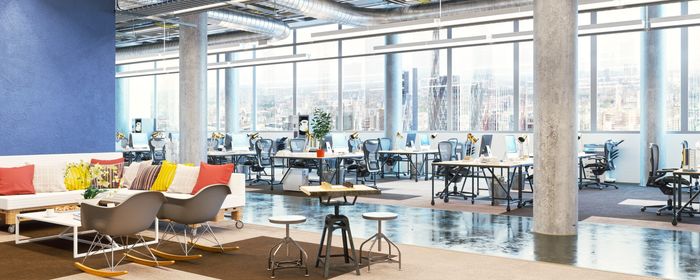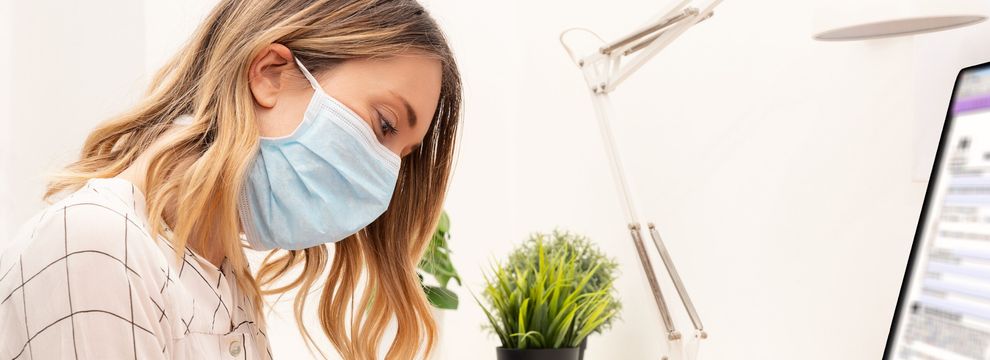The CDC released updated guidelines about COVID-19 Employer Information for Office Buildings.
Office building employers, building owners and managers, and building operations specialists can take steps to create a safe and healthy workplace and protect workers and clients. The CDC recommends the following:
- Create a COVID-19 workplace health and safety plan
- Before resuming business operations, check the building to see if it’s ready for occupancy
- Identify where and how workers might be exposed to COVID-19 at work by conducting a thorough hazard assessment of the workplace
- Develop hazard controls using the hierarchy of controls to reduce transmission among workers. Include a combination of controls noted below:

Companies are preparing to bring employees back to workplaces and reopen offices in the coming weeks and months. In a COVID-anxious world, what will the workplace look like and how will it change? How do you safely bring employees back, and more importantly, what if they don’t want to return? HR, Security, and Facilities Teams are tasked with providing clear, informative guidance that will prioritize a people-first approach to safety and security. In an effort to equip business owners and stakeholders with the tools and resources needed to return to work, we’ve compiled a resource guide for HR, Facilities, and Security Teams that covers critical areas of concern.
What Does a Workplace Look (and Feel) Like During the COVID-19 Pandemic?
Hand sanitizer dispensers on the walls, workstations six feet apart, increased cleaning protocols — is that what the workplace looks like while COVID-19 remains a serious threat? Probably, but how the people working in your office feel is much more important.
Employees returning to the office post-quarantine are likely to be highly concerned about exposure, and may even exhibit symptoms of PTSD. Many of them may not like to come back at all or may prefer to continue working from home. Those who do return to the office will expect the workplace to be healthier, cleaner, socially distant, and empathetic.
It’s a big challenge for businesses to adjust to the new norms and standards of safety while also staying productive and profitable.
- How do we transform the work culture to align with social expectations and legal frameworks as the pandemic plays out?
- How do we deal with difficult issues such as redundancy, layoffs, sick leave, insurance, and remote working?
- How do we care for the employees so they stay motivated, productive, and engaged?
Social Distancing and Why It Matters
Practicing social distancing can reduce the rate of new infections by limiting person-to-person transmission. Reducing the rate of disease transmission through interventions, including social distancing and other measures, can alleviate the burden on medical facilities. The U.S. Government Accountability Office released a Science & Tech Spotlight on Social Distancing During Pandemics that addresses what social distancing is, how it mitigates infectious disease spread, and the current challenges around implementing it. Social distancing is a new concept to most people, but it has been studied in past virus outbreaks.
It is important to note that social distancing is not an exact and perfect solution, but scientific studies have shown its effectiveness in other scenarios of virus outbreaks. For example, studies examining the use of social distancing during the 1918 influenza outbreak and the 2003 SARS outbreak showed such a reduction in part due to social distancing.
How to Prepare for Returning to Work
The COVID pandemic is unlike anything that businesses and society have experienced in a century. It’s complicated to make predictions or prepare for every ramification of the crisis. What’s known is that the pandemic is forcing governments and regulators to impose unprecedented health and safety standards on the local, state, and federal level — and many conflict or vary depending on geographic location and specific circumstances. Businesses will continually adjust to their new way of working and moving forward in a COVID world.
Resources for HR Teams
Business owners and HR managers should use time in quarantine to come up with practical solutions and guidelines to help personnel adjust to traumatic change while maintaining productivity. The following checklist will help your HR Team create a workplace that is an empathetic, people-first environment, sensitive to the physical and mental well-being of employees.
Workers will be concerned about pay, leave, safety, health, benefits, insurance, privacy, and other issues that may arise during infectious disease outbreaks. Can I take time off from work if a family member or I become sick with the coronavirus? What benefits am I entitled to under the Families First Coronavirus Response Act? Will I be paid for the time that I’m working from home? Will I be electronically monitored while I’m working on my laptop? The HR team should understand people’s concerns and proactively address their questions before they even ask.
In preparing a plan for returning employees to the workplace, these are the things HR teams need to consider:
- Adjust, clarify, and explain compensation, leave, and layoff policies
- Enable remote working (for short-term and long-term)
- Communicate the norms and expectations of remote working including the communication platform to be used, schedules to be followed, any monitoring measures used, etc
- Adhere to recommended CDC cleaning policies and procedures
- Maintain six-foot social distancing within the workplace, rearranging workstations, common areas, and schedules as necessary
- Arrange regular briefings or online meetings covering the ways that the company and staff can mitigate Coronavirus risks
- Ensure employee health and well-being by being sensitive to emotions and concerns
READ MORE Prepare to Return to Work: Resources for HR Teams
Resources for Security and Facilities Teams
The existing protocols and procedures companies have surrounding safety and security are most likely not applicable in the current pandemic environment. As businesses continue to slowly reopen and remote-working employees start to return to the office, security and facilities teams need to prepare a comprehensive plan that is clearly communicated to all stakeholders.
In preparing a plan for returning employees to the workplace, these are the things security and facilities teams need to consider:
- Management should agree on a consistent message before communicating, in a unified voice, a resumption process
- Communication, likely via email, should acknowledge the difficulty that we have all shared the last few weeks/months, and thank them for their part in flattening the curve
- Security should emphasize the availability of HR staff and the company EAP to care for their well-being
- Facilities should communicate planned changes in office design, but allow the staff to participate in the process so they have ownership and can put their mind at ease
- Security staff may need to help create social distancing, perhaps by marking floors early on and policing for improper activity
- Security should consider refresher training on de-escalating tense situations
- Consider installing or at least trialing touchless access control, typically via biometrics; assess the various biometrics such as face recognition, voice, iris, retina, gait, etc
- Ensure that the IT infrastructure is robust, secure, and scalable — now might be a good time to invest in improvements
- Explore whether it is worth implementing a monitoring system that ensures staff productivity; it may have the opposite effect of communicating distrust and demotivating workers
READ MORE Prepare to Return to Work: Resources for Security and Facilities Teams
What Is the New Model for Cleaning and Hygiene in the Workplace?
In order to keep employees safe until there is a vaccine for COVID-19, prevention is the only cure we have right now. New standards of cleaning and hygienic protocols are being recommended by the CDC and WHO to help stop the spread of the virus.
According to the CDC, the coronavirus spreads mainly from person to person through respiratory droplets that are sprayed into the air when an infected person coughs or sneezes. Additionally, breathing expels (a smaller amount of) droplets as well, so being in close proximity to someone over time may transmit enough of the virus to contaminate someone. The infection can either spread directly to people standing within 2 meters of a sick person when they inhale the droplets while breathing. People can also become infected by touching a surface, object or the hand of an infected person that has been contaminated with respiratory secretions and then touching their own mouth, nose, or eyes.

Routine Cleaning of Workplaces and High Touch Areas
OSHA, CDC, and WHO recommend that all frequently touched surfaces in the workplace be routinely cleaned. High-touch surfaces include tables, doorknobs, light switches, countertops, handles, desks, phones, keyboards, toilets, faucets, sinks, etc. These are to be cleaned as a matter of routine using normal cleaning agents. No additional disinfection beyond routine cleaning is recommended unless someone in the workplace becomes infected.
Use EPA-approved disinfectants on commonly touched surfaces such as door knobs, keyboards, remote controls, etc. Provide disposable wipes and instruct all workers to clean the shared surfaces before and after every use. Soft surfaces such as curtains, carpets, drapery, etc should be cleaned and washed routinely using the detergents that are usually used for cleaning and washing them. Keep napkins, sanitizer, and/or wipes on either side of doors.
Implement Cleaning Protocols After Discovering an Infected Employee
If a person becomes infected, clean and disinfect all areas and equipment used by that person. The area where the sick person was working needs to be cordoned off. Wait for at least 24 hours before moving in for the cleaning, just as a precaution to make sure the virus has outlived its viable life span. The affected area can be opened for work to other employees after it has been disinfected.
Train Cleaning Staff
Cleaning staff are on the frontline in the fight against COVID-19, whether they’re doing routine cleaning, laundry, or trash disposal. Workers must wear disposable gloves and masks while cleaning and disinfecting different areas. Gloves themselves can pick up the virus, so they should be disposed of at regular intervals. Anyone wearing gloves should remember not to touch their face.
Workplace managers should educate cleaning workers to recognize the symptoms of COVID-19. Provide instructions on what to do if they develop symptoms within 14 days after their last possible exposure to the virus. Create policies for worker safety and provide training to all in-house cleaning staff prior to assigning cleaning tasks. Training should include when to use PPE, what PPE is necessary, how to properly wear PPE, and how to properly dispose of PPE.
Utilize Technology
Face recognition technology can be used to provide touchless access to the office. Access control systems like Swiftlane eliminate the need for biometric scanners, pin pads, or key cards to access the office. The AI based systems can be developed to identify sick employees and their close contacts and actively monitor workplace health and hygiene.
In addition, many companies are using thermal detection systems at entrances to detect staff with elevated body temperatures, though their effectiveness is being questioned.
The Future of Remote Working
If anything has become crystal clear during the Covid-19 pandemic, it’s that not every remote worker will return to the office. Despite initial fears, staff working at home has yielded a huge dividend to businesses: improved efficiency, reduced overhead costs, barely affected productivity. And the prospect of jettisoning square footage of brick-and-mortar office space has CFO’s drooling. In fact, remote work has been such a financial boon that some companies are reallocating commuting reimbursements to funding staff members’ home-office environments.
It’s been estimated that 25% to 30% of the workforce will be working from home multiple days per week by the end of 2021. And it’s likely that the environmental benefits of less commuting and the desire to retain top talent will contribute to the likelihood of long-term home-based workforces.
Already, Twitter has announced that workers can work from home “forever,” real estate startup Culdesac has gone all virtual, and Facebook and Google are allowing staff to stay out of the office until at least the end of 2020. Other companies are bound to follow these examples. A recent Gartner survey found that 75% of companies expected some of their employees to switch to remote work on a permanent basis.
Pros and Cons of Remote Work
Pros:
- Reduced overhead costs
- Saved commuting time
- Easier to care for family
- Access to global talent
- Flexible hours
Cons:
- Decreased social interactions
- Fewer spontaneous encounters
- Siloed communication
- Difficult to identify disengaged employees
- Harder to foster culture
- Distractions
- Social isolation
- Difficult to control network/cybersecurity
For companies who want to expand remote work capabilities, here are issues to consider when revising work-at-home policies:
- Do staff have the appropriate technology and secure network connections?
- Are processes and technology in place to protect data and network resources?
- Will IT specialists service employee technology at their homes?
- Will HR staff assist with home-office ergonomics?
- Will companies provide stipends for enhancing home offices?
- How often will managers require check-ins with staff? And by what means? (e.g Zoom, Slack, Notion, Teams, phone calls, email, SMS)
- Will staff be expected to be “available” at certain hours?
- Will staff be expected to respond to communications such as emails within certain time frames?
- Is there a fair process for evaluating work performance?
- Have you considered remote work in the context of workers compensation?
- Will staff ever be required to come to the office or travel to a different site?




